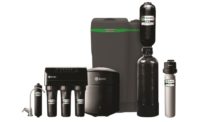When selecting water filters for buildings or businesses, some contaminants of concern likely come to mind first — such as lead, arsenic or fluoride; but other contaminants are also worth considering when looking for the right filter.
Over the last several years, two specific subsets of emerging contaminants have appeared on news channels as their effects become clearer as data is collected: Per- and polyfluoroalkyl substances (PFAS) and microcystin.
Concerns about PFAS
Drinking water contamination by per- and polyfluoroalkyl substances (PFAS) continues to be a major topic in the news. In 2019, the Environmental Working Group announced an update to its map of known PFAS contamination sites, which includes 610 sites in 43 U.S. states. These sites include 446 communities with detection of PFAS contamination in local tap water supplies.
PFAS compounds are synthetic, man-made chemicals that are highly persistent and slow to environmental degrade. The U.S. Environmental Protection Agency (EPA) considers them to be emerging contaminants. The two most common PFAS compounds are perfluorooctanoic acid (PFOA) and perfluorooctane sulfonate (PFOS) acid. Historically, these chemicals were used in the manufacturing of fluoropolymers, and have a unique ability to withstand water and grease exposure, as well as high temperatures. These qualities make them especially useful for applications such as paper and cardboard food packaging, insecticides, electronics, stain repellants, paints, plumbing tape, firefighting foam and non-stick cookware coatings.
Although PFOA and PFOS production was phased out in the early 2000s, large quantities of these chemicals remain present in the environments surrounding manufacturing locations and areas where they were used for commercial and industrial purposes. The EPA added PFOA and PFOS to its Unregulated Contaminant Monitoring Rule 3 (UCMR3) that was promulgated in 2012.
Public health response to PFOA/PFOS
To address PFAS contamination and the need to have consensus methods for evaluating the effectiveness of point-of-use (POU) and point-of-entry (POE) technologies for treating PFAS contamination of drinking water, NSF International’s Joint Committee for Drinking Water Treatment Units (DWTUs) has been hard at work developing protocols and standards to meet the evolving needs of stakeholders.
At its 2018 meeting, the joint committee voted unanimously to establish requirements in the NSF/ANSI DWTU standards for reduction of PFOA and PFOS by activated carbon, anion exchange resin and POU reverse osmosis (RO).
Since then, the requirements, including test protocols, for evaluation of activated carbon systems for reduction of PFOA and PFOS have been added to NSF/ANSI 53 and to NSF/ANSI 58. Work continues to develop a test protocol for treatment by anion exchange resin, which will be added to NSF/ANSI 53.
The contaminant reduction test protocols for activated carbon and POU RO were based very closely on the protocols previously developed for NSF P473: Drinking Water Treatment Units — PFOA & PFOS. It is expected that the protocol for anion exchange resin will be based on the protocol for reduction of perchlorate by anion exchange resin that currently exists in NSF/ANSI 53.
Concerns about cyanotoxins/microcystins
Another group of emerging contaminants to be considered are cyanotoxins, which include microcystins. These highly toxic substances can be found in surface waters where cyanobacteria (blue-green algae) are present; the cyanotoxins are a by-product of the algae’s lifecycle. As a result, cyanotoxins can be present in finished drinking water supplies when algae blooms produce the compounds and treatment is inadequate.
Exposure to cyanotoxins through drinking water and/or recreational water has been known to harm human health, causing a wide range of symptoms including liver and kidney damage in more severe cases. When cyanotoxin levels spike above safe amounts, consumers are urged to seek alternative water supplies.
Public health response to microcystins
In 2015, in response to these compounds being detected in finished drinking water supplies in the U.S., the EPA set recommended health advisories for microcystins in drinking water at or below 0.3 µg/L for children less than 6 years old, and at or below 1.6 µg/L for older children and adults.
As improved detection methods revealed the presence of these compounds in drinking water, the actions of the EPA have helped to create significant consumer and regulatory interest in POU products that can effectively treat microcystin contamination. In response, NSF developed a new protocol, NSF P477: Drinking Water Treatment Units – Microcystin to cover POU active media systems, such as those that fall under the scope of NSF/ANSI 53. NSF P477 was subsequently reviewed and approved by the NSF joint committee to be merged into NSF/ANSI 53.
Careful and considered work has gone into validating the protocol as a robust basis for product certification. Scientists did extensive work to locate and validate sources of microcystin, and then refined analytical methodologies to allow accurate and precise identification and quantification of microcystin in drinking water. NSF then investigated the performance of various types of active media in treating microcystin in drinking water as part of the validation testing phase of protocol development.
Actionable steps you can take
To find a filter that reduces specific contaminants, first you should verify that the device is certified by checking the appropriate certification body’s official listings. For example, drinking water treatment units certified by NSF International can be found at info.nsf.org/Certified/DWTU. Once you access the certification listings, you can select contaminants that are of concern and the products that are certified to reduce those contaminants will appear. You can also search by manufacturer, product type or standard.



